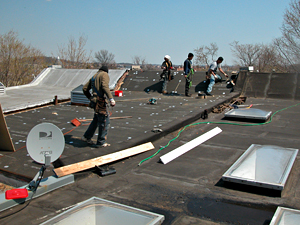 Let's review, shall we?
Let's review, shall we? I'm in the city, I want to keep bees, and I want to annoy (and become known to) as few people as possible. Therefore, my bees are on a roof deck, and the only people who should be able to see me up there are the folks in an apartment house about a block away (who should not care) and some people with a roof deck just around the corner, whom I avoid.
So in less than a year, BOTH neighbors have their entire roof decks replaced, and it's not just the supporting joists that get exposed. My northside neighbor had told me that roofers would be coming, supposedly two weeks ago, and that she would call me the night before "so I would not be alarmed by the noise." I wondered then if she already knew, but I got information from the BeeSource folks about how to block the girls in (safely) for a day, so I figured all would be well.
But today the roofers arrived without warning, and so they get to see my girls in action! I decided to ask them if I could take their picture, and they said yes, and that was probably a good thing. As I was standing there, bees were bumping into my head and buzzing all around me on their way in and out, and I was barefoot. If a crazy yuppie woman showed so little fear, it appeared as if the macho factor was gonna keep these guys from objecting!
It's probably a good thing that just yesterday, ahead of a short drizzly rain, I did my interim check on the girls. I have hung back for the past two weeks, in part to try to gain perspective and calm down, and in part to allow them to recuperate from my many disruptions. This is the time of year to be careful about food stores, and to apply any Spring varroa mite treatments, and to decide whether any surplus stored honey should be removed in advance of the Spring nectar flow. So I just popped the covers and pulled the bottom boards for an in-progress scan.
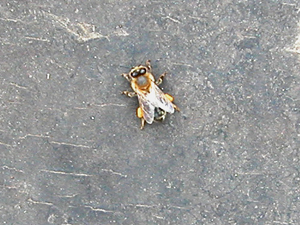 This girl was hanging out nearby as I lit my smoker, so it seemed like she wanted to pose with her sporty pollen packs. Those little yellow cuffs on her legs, near the ends of her wings, are probably maple pollen, and she seemed kind of heavily laden and taking a break. After a couple of pictures (the others were out of focus) she flew home.
This girl was hanging out nearby as I lit my smoker, so it seemed like she wanted to pose with her sporty pollen packs. Those little yellow cuffs on her legs, near the ends of her wings, are probably maple pollen, and she seemed kind of heavily laden and taking a break. After a couple of pictures (the others were out of focus) she flew home.The Wilde colony got the first check. When I popped the top, a wave of warmth and sweet smell reached me. The girls are definitely raising brood in there, and keeping the temps high for the bees to be.
 The Wilde girls still have a decent amount of food, and the frame picture at right seems to indicate that they are sort of pecking away at their honey stores, and maybe bringing in a bit of the nectar that is now available in the wild. MaryEllen says that the bees prefer fresh nectar – that the honey they store is about as appealing as canned veggies are to us, and I suppose that it could get old after 4 or 5 months of winter – and that they will ignore honey when flower juice is available. The pattern on this comb seems to show that sometimes they eat fresh, and sometimes they are still plugging away at the comb honey. There seemed to be enough honey to support this pattern for a while, and the weather is supposed to continue in a pro-bee fashion this week, so I closed up and left them alone.
The Wilde girls still have a decent amount of food, and the frame picture at right seems to indicate that they are sort of pecking away at their honey stores, and maybe bringing in a bit of the nectar that is now available in the wild. MaryEllen says that the bees prefer fresh nectar – that the honey they store is about as appealing as canned veggies are to us, and I suppose that it could get old after 4 or 5 months of winter – and that they will ignore honey when flower juice is available. The pattern on this comb seems to show that sometimes they eat fresh, and sometimes they are still plugging away at the comb honey. There seemed to be enough honey to support this pattern for a while, and the weather is supposed to continue in a pro-bee fashion this week, so I closed up and left them alone.The Twain hive seemed a better candidate for extracting, based on the fact that I left them over 100 pounds of honey this winter, and the first deep frame I pulled was still full of honey. Toward the center of the deep box, however, I found that the cluster had moved into the bottom part of the middle frames: they might not need all this honey, but they'd probably be wanting some. So I decided to let it ride here, too. I moved the full frame to the middle (it's safer to move honey frames around than brood comb), took off the hive top feeder for cleaning, and closed it up.
For the past two Fridays, without telling you, I have been restarting the oxalic mite treatments because there are still several workers with deformed wings appearing each day, and the temperatures have been too low to use ApiLife Var. When I pulled the bottom boards, it does seem like the mite drop is receding, but the virus itself might not need the mites anymore if enough bees are transmitting it directly. Who knows? They say that the worst sign is if drones emerge with deformed wings – they are supposed to have greater resistance – and I have not seen any of them. I can only take what care is available, and be gentle.
Finally, with the Spring have come a number of invitations to place bees in new locations, including a monastery a bit over 3 miles (a perfect distance) from my roof. MaryEllen and I are collaborating on yet another bee project at a public historical park in the suburbs, and we gave a presentation to the other volunteers there not long ago. We'll make all this the subject of another post, since this one is so long.
Finally, I am sorry for the gap in posting, for those of you who wonder about such things. There has been a death in my family, not a terribly happy family, and I sometimes wonder if my love for the bees and their tight and collaborative world has anything to do with these long-past heartaches. Nonetheless, I've been in a pointlessly thoughtful fog, and welcome the needs and rhythms of the bees to bring me back to the world of the real and the alive.
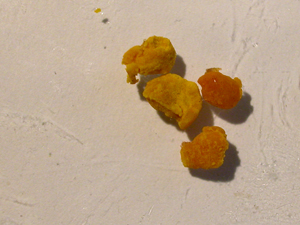 Spring has continued its early arrival in these parts with an 85 degree F day, which I celebrated by pulling the sliding panels out from the screened bottom boards of the hives. This gives the honeybees additional ventilation, and I get to look at what's been falling through lately. They also don't care at all about this operation, and are not disrupted in the least.
Spring has continued its early arrival in these parts with an 85 degree F day, which I celebrated by pulling the sliding panels out from the screened bottom boards of the hives. This gives the honeybees additional ventilation, and I get to look at what's been falling through lately. They also don't care at all about this operation, and are not disrupted in the least.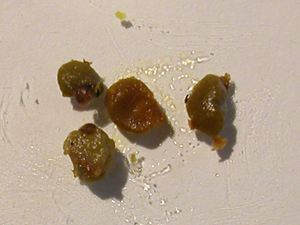 This olive drab stuff is willow pollen, apparently a far less desirable product, according to beekeepers. The bees seem to think it's OK. The Twain colony had a lot of maple on the bottom board, while Wilde had almost all of the willow. This may only mean that the Wilde girls filled up the cells with willow before working on maple, or it might mean nothing at all.
This olive drab stuff is willow pollen, apparently a far less desirable product, according to beekeepers. The bees seem to think it's OK. The Twain colony had a lot of maple on the bottom board, while Wilde had almost all of the willow. This may only mean that the Wilde girls filled up the cells with willow before working on maple, or it might mean nothing at all. 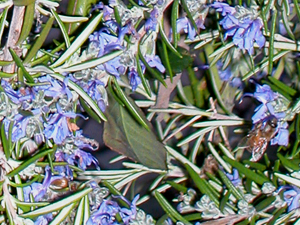 If the bees were ready to swarm, they would have done it today, so I kept an eye on them. Instead of waving goodbye to a cloud of departing residents, however, I got to supervise a glorious working day for many hundreds of busy honeybees.
If the bees were ready to swarm, they would have done it today, so I kept an eye on them. Instead of waving goodbye to a cloud of departing residents, however, I got to supervise a glorious working day for many hundreds of busy honeybees.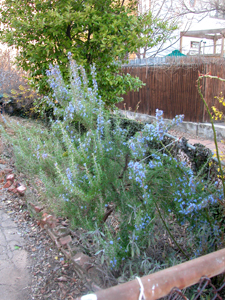 And it turns out that the bees had found this rosemary bush, gloriously in bloom, in the yard of a neighbor who does not like me much. Honeybees on the job are notoriously difficult to photograph, and I was afraid to go in this yard, so I leaned on the fence, propped up the camera, and crossed the fingers that weren't pressing the shutter. Within a set of some 20 nearly random shots, the first picture above and the last one below managed to show happy honeybees in their first Spring blooms.
And it turns out that the bees had found this rosemary bush, gloriously in bloom, in the yard of a neighbor who does not like me much. Honeybees on the job are notoriously difficult to photograph, and I was afraid to go in this yard, so I leaned on the fence, propped up the camera, and crossed the fingers that weren't pressing the shutter. Within a set of some 20 nearly random shots, the first picture above and the last one below managed to show happy honeybees in their first Spring blooms.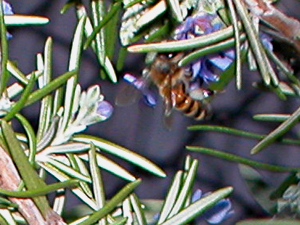 This officially marks the beginning of the season where my poor dogs will have to wait as I poke my head into every bush during their walks, looking for the girls. It's time to root for even temperatures and nighttime rains, for abundant nectar and gentle winds. It's time to realize that it's way too soon for these things, but to feel them tantalizingly just ahead.
This officially marks the beginning of the season where my poor dogs will have to wait as I poke my head into every bush during their walks, looking for the girls. It's time to root for even temperatures and nighttime rains, for abundant nectar and gentle winds. It's time to realize that it's way too soon for these things, but to feel them tantalizingly just ahead.
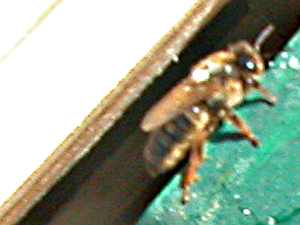 If you have been looking here for beekeeping advice, please let this post be your version of the surgeon general's warning. I am a moron beekeeper. At left is the only worthwhile result of this morning's endeavors: a fuzzy picture of a slightly marked queen.
If you have been looking here for beekeeping advice, please let this post be your version of the surgeon general's warning. I am a moron beekeeper. At left is the only worthwhile result of this morning's endeavors: a fuzzy picture of a slightly marked queen.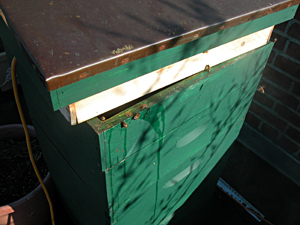 A few weeks ago it became clear that I had to watch the Wilde colony for signs of swarming: Carniolans are known for it, and my bees were crowded. Since the weather is supposed to be quite warm by the end of the week, I popped the top (the picture here today) to check, and found no signs of honeybees with plans to run away from home.
A few weeks ago it became clear that I had to watch the Wilde colony for signs of swarming: Carniolans are known for it, and my bees were crowded. Since the weather is supposed to be quite warm by the end of the week, I popped the top (the picture here today) to check, and found no signs of honeybees with plans to run away from home. You may wonder why this bee blog is showing you a picture of a building. Well, it's like this: We just took a midwinter break, a quick run down to Merida, Mexico – a city in the Yucatan, and I look for bees everywhere. I thought the most exciting bee-attraction in Merida would be it's large open market (the biggest on the whole peninsula), a place I'd *surely* find interesting honey and bee products. However, as we were walking along the zocalo (the central square and park for the city), I noticed bees flying behind and around giant crests on an impressive old building.
You may wonder why this bee blog is showing you a picture of a building. Well, it's like this: We just took a midwinter break, a quick run down to Merida, Mexico – a city in the Yucatan, and I look for bees everywhere. I thought the most exciting bee-attraction in Merida would be it's large open market (the biggest on the whole peninsula), a place I'd *surely* find interesting honey and bee products. However, as we were walking along the zocalo (the central square and park for the city), I noticed bees flying behind and around giant crests on an impressive old building.